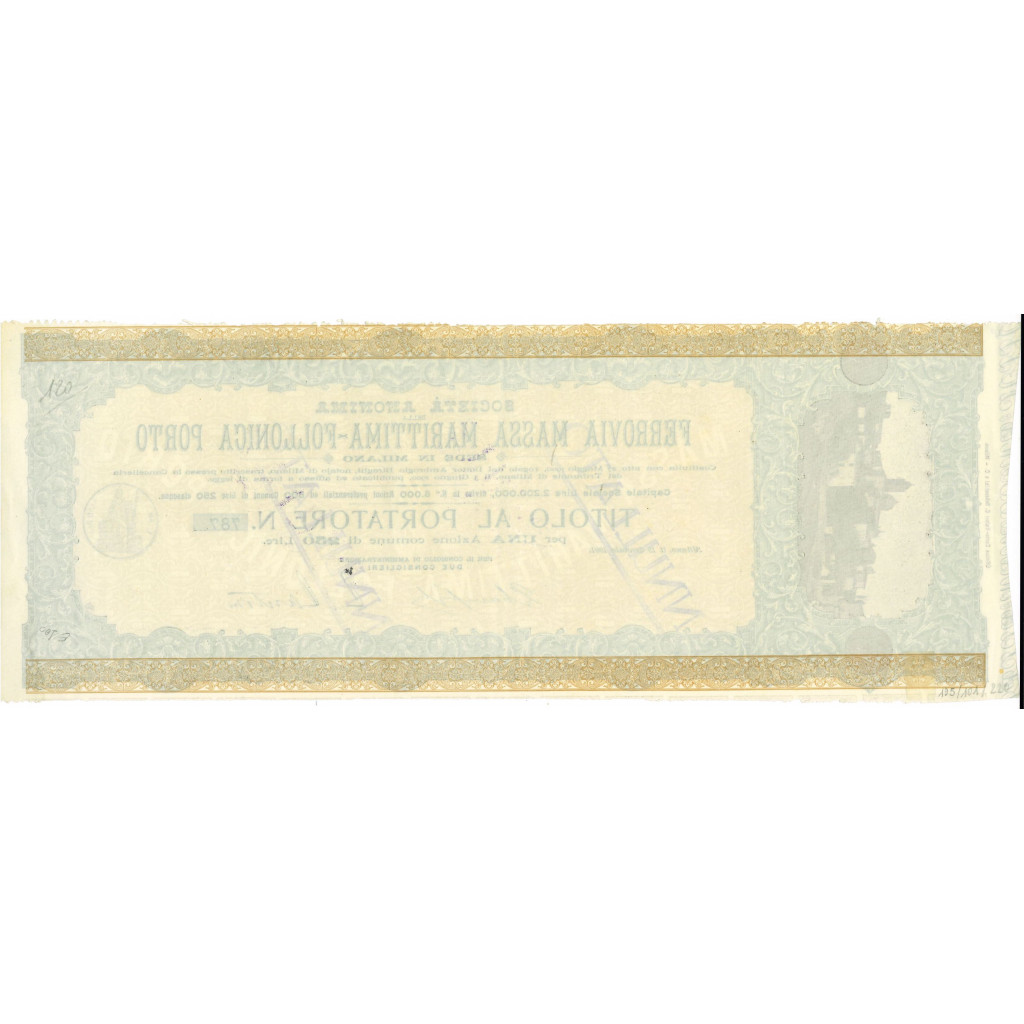ID: 1105
BEARER BOND FOR A BOND
INCORPORATED MAY 27, 1900
The Massa Marittima-Follonica railway was an Italian concessionary railway line, opened in 1902 and closed in 1944, connecting the town of Massa Marittima with the port of Follonica.
The project and construction
An initial project for a rail link between the port of Follonica and the Colline Metallifere was presented to the Parliament of the Kingdom of Italy in 1882, but was rejected. Drawn up by engineer Alceo Taddei of Chiusdino, the project called for the construction of a 76-kilometer-long railroad, strongly desired by both the Massa Marittima administration and the companies active in the mining industry that managed mineral extraction in the area. The line was also considered strategic from a military point of view, as it would have been the only railway to cross central Italy transversely.
At the dawn of the 20th century the situation changed: in 1899 a Royal Decree[2] mandated, on behalf of the municipality of Massa Marittima, the establishment of a joint-stock company to which the entrepreneur from Padua, Pericles Tzikos, and the Bulgarian engineer Emilio Török were to commission the construction of the railway. The idea was to build an ordinary-gauge railway connecting the Tuscan hinterland to the Tyrrhenian coast at the height of the port of Follonica, based on a plan drawn up in 1887 by engineer Telemaco Parri of Follonica and architect Manfredini of Florence and revisited in 1890 by incorporating some variations imposed by the General Inspectorate of Railroads[1]. The Massa Marittima-Follonica Railway Limited Company (FMF) saw the light of day in 1900.
The FMF was part of a larger group of railway concessionaires, called the Società Italiana per le Strade Ferrate Sovvenzionate (SFS), which already operated the Poggibonsi-Colle Val d'Elsa, Benevento-Cancello and L'Aquila-Capitignano railways[4]. The construction of the Massa Marittima-Follonica railway was immediately started and was completed with the inauguration of the entire track on December 11, 1902. The line's track originated at the port of Follonica and reached the opposite terminal at Massa Marittima-whose station was located at Ghirlanda-after a 25-kilometer route and a total elevation difference of more than 350 meters.
On the line, freight service, which flourished from its earliest beginnings and consisted mainly of moving ore extracted from the Val d'Aspra mine to the port of Follonica, was assisted by a passenger service with mainly local scope. Initially operated with steam traction, the entire railway was later electrified.
The decline of traffic
Established essentially as a mining railroad, the line was heavily affected by the crisis that resulted from the Great Depression: mineral prices plummeted and with them traffic on the railroad, both freight and passengers, also contracted sharply. The volume of material transported fell from 165,000 tons handled in 1920 to a mere 30,000 tons in 1930; this reduction in freight traffic was also accentuated by the decision of the Montecatini company to stop using the railroad for the transport of goods and to use its own cable cars, more than 30 km long in total, to forward the mined minerals to Scarlino and the sea, thus saving on transportation costs[5].
On February 1, 1933, with the FMF forced to economize on operations, passenger service on the railway was suspended and replaced with a self-service. Freight traffic, while not reaching pre-crisis levels, remained at sufficient levels in the late 1930s to ensure the concession company's economic equilibrium[6]. On May 31, 1941, in order to provide for the inadequacy of the road service, a makeshift passenger service was restored on the line; in addition to the carriages used before the service was discontinued, it was hypothesized to use the new T5 type Laviosa railcars, which had already been experimented on the Massa tramway, operating a gauge reduction on the entire route of the railway. In the end this project did not materialize, and FMF resorted to the acquisition of the C 563 coaches owned by Ferrovie Nord Milano.
The war and the suppression
In May 1944, service on the line was discontinued due to extensive damage by retreating German troops,[1] who demolished the bridges over the Pecora River and Petraia Creek and destroyed the railway's only underpass[7]. The Commission for the Reactivation of Public Transportation Services, established by Lieutenancy Decree No. 346 of October 15, 1944, deemed the reconstruction and reopening of the Massa Marittima-Follonica railroad unnecessary, and it was formally abolished in 1948.




